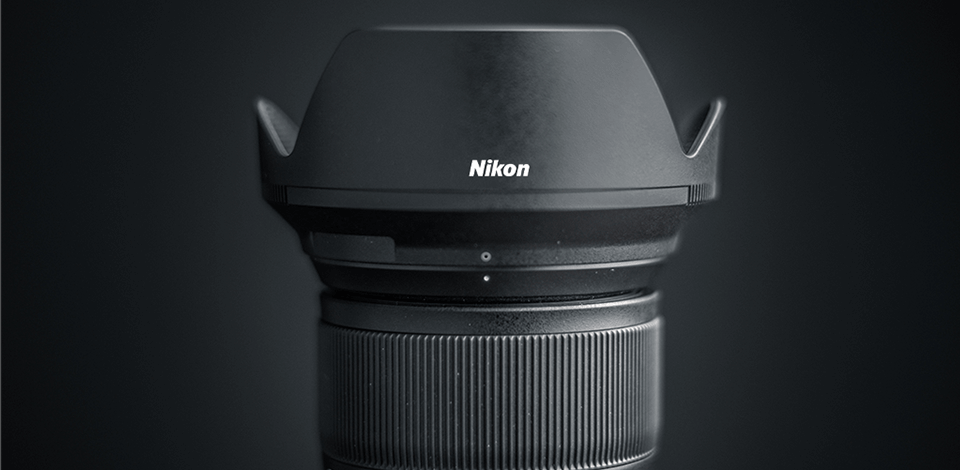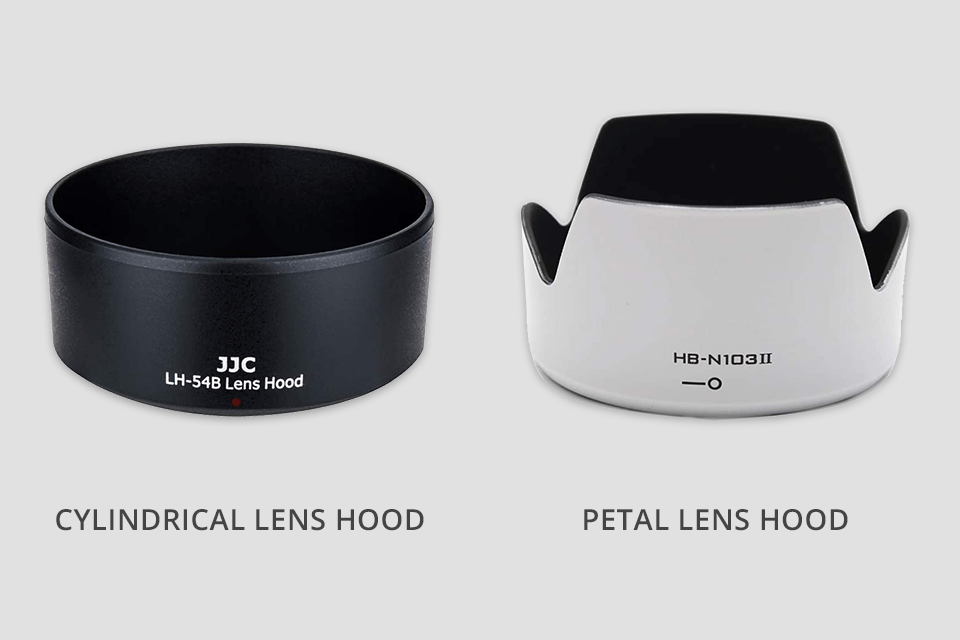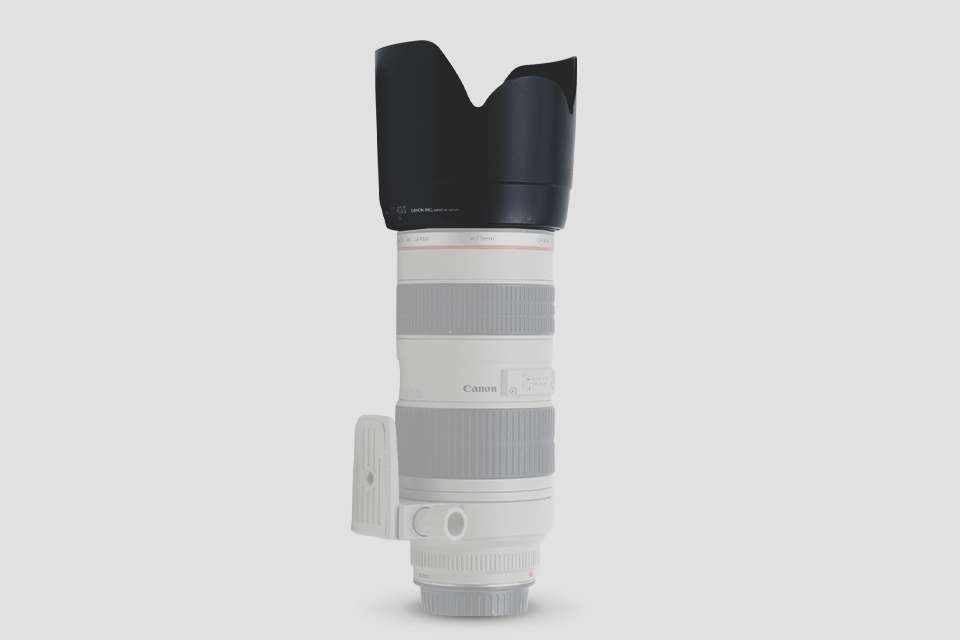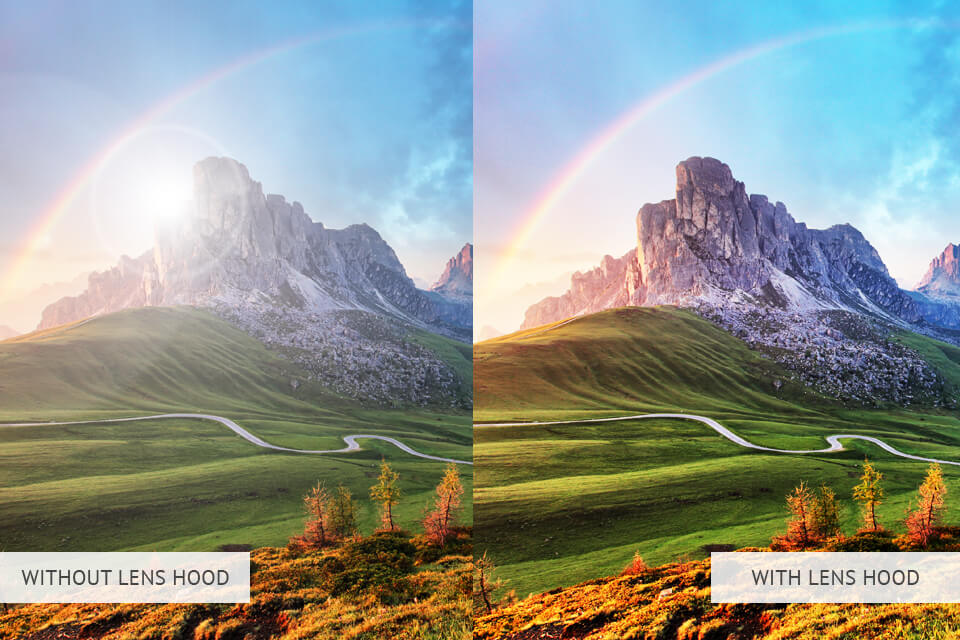
A camera lens hood is attached to the front part of a lens. It blocks unwanted light and prevents overexposure and light leaks. Besides, it helps you protect your camera lens from damage if you incidentally hit it. By using this lightweight accessory, you can significantly improve the image quality and ensure that your lens will last longer. This is why most photographers use lens hoods whenever they can.

All lens hoods are similar in design. There are two main shapes: a cylindrical shape and a petal one.
Cylindrical lens hoods. Such models are perfect when you need to block unwanted light and protect your equipment. For instance, you may buy the JJC LH-54B or other similar models. They are often sold together with a prime or telephoto lens. These lens hoods are typically quite long, but you won’t see them in the frame if you use a long focal length. There are also cylindrical lens hoods made of rubber on the market. They are perfect for travelers as you can flatten them when you don’t use them.
Petal lens hoods. Such models are also called tulip lens hoods. For instance, the HB-N103 II has a petal shape. These lens hoods are quite short and block out light effectively thanks to their curved notches. You can use them with wide-angle lenses and full-frame camera sensors.
Such lens hoods have four petals. You can rotate them to ensure that they won’t be visible in the frame.

You can easily attach a camera lens hood without wasting a lot of time. Many lenses come with a lens hood. Pay attention to a marking as it will help you to attach a lens hood correctly. Align the marks and then twist the lens hood until is attached to the lens securely. You will hear a click when it happens.
Older models were screwed onto the lenses. If you have one of them, you don’t need to worry about markings. Fix the lens hood securely in place using the screw on the side. I noticed that some large, metal lens hoods usually come with a screw. They are typically used with big lenses.
Some amateur photographers attach lens hoods backward. It might make it impossible to use the rings on your lens. If you have some difficulties with attaching a lens hood, check out if you are doing it in the right way.

There are multiple reasons to use a lens hood. Such an accessory will be especially useful for those who are interested in nature photography or often work with powerful light sources. When working with different lighting setups, make sure to use a lens hood to reduce flare.
If you are wondering whether a lens hood is actually useful, read on to learn how you can improve your photos by attaching it to the camera’s lens.
The main purpose of a lens hood is to minimize lens flare. If you have ever taken photos on a sunny day or in a brightly-lit studio, you might already know how many problems might be caused by flares and light leaks. You might not notice flare when taking photos, but such defects will be difficult to remove during post-processing.
These problems happen if you use budget filters or a lens with a cheap anti-flare coating. Some lenses are more prone to capturing flare than others.
By attaching a lens hood to your lens, you can prevent flare and take photos with rich colors. Besides, this accessory allows you to improve contrast. Provided you use it in the right way, it won’t affect the quality of your images even when you take photos on a sunny day. Remember that any light source might lower the contrast. This is why it’s better to use a lens hood to prevent this issue.

You might be asking yourself: “Why use a lens hood?” Besides improving the quality of your images, a lens hood protects your lens from impact, scratches, fingerprints, and other possible damage. A lens hood won’t save your lens if you drop it, but it will minimize possible damage. It’s better to have a damaged lens hood than a broken frontal element of a lens.
Lens hoods also protect a lens from rain and snow, which allows you to take top-quality photos in different shooting conditions.
Note: Professional photographers know that it might be difficult to take a creative photo without paying attention to lighting. When experimenting with light sources, you can’t do without a lens hood.
The only disadvantage of a lens hood is that it might put a part of the frame in shadow if you use an in-built flash. This is why it’s better to use an external flash with a lens hood.

We have briefly outlined the key advantages of a lens hood and the reasons for buying one. These accessories are perfect for professionals interested in landscape photography. Many photographers are wondering: “When to use a lens hood?” Below, we have described the main situations when you might need to use a lens hood to improve the quality of your photos.
To take professional-looking photos, you need to take care of the lighting. When shooting outside or in a room where there are too many light sources, it might be difficult to protect your lens from unwanted light. Even if you create a perfect composition, it might be impossible to fix all the issues caused by leaked light during post-processing.
When taking photos on a sunny day, you might notice that it’s difficult to snap pics with perfect contrast.
Using a lens hood, you can ensure that you won’t have any issues with contrast. It will make it easier for you to edit your photos afterward. You won’t need to spend hours trying to remove lens flare.
When traveling across Norway and Iceland, you may capture a lot of picturesque landscapes along the way. The only disadvantage is that in some areas you might drop your camera. It may also get damaged due to poor weather. This is why it might be a good idea to start using a lens hood for extra protection.

Despite some obvious advantages of these accessories, there are several cases when it will be impossible to use a lens hood or when you might not want to use it for other reasons:
Photographers avoid taking photos with glare, however, in some cases, you might watch to capture it. When taking a photo with an IR camera, you will notice a lot of flare in the frame, but it’s what makes such images stand out. In some cases, though, it will be the right decision to take off a lens hood.
Sometimes, you need to take off a lens hood as it might be visible in the frame. It happens when you use a lens designed for cameras with a small sensor, for instance, the Nikon DX lens with an FX camera.
However, some lenses, such as fish-eye lenses, will capture a part of a lens hood when you use a wide focus distance. In this case, you will need to take off the lens hood to see everything clearly.
It often happens that a photographer uses additional lens accessories, like diffusion filters that make it impossible to attach a lens hood. If it’s crucial for you to use this accessory, keep using it without a lens hood.
Some photographers avoid using a lens hood when taking specific types of photos. If you use an in-built flash, you might capture the shadow of a lens hood. This is why it’s better to take it off.
Finally, if you take photos in windy weather, it’s better to take off a lens hood to minimize vibrations. It’s especially important for those who use a telephoto lens or take photos when flying a helicopter with an open window. In most situations, it’s better to use a lens hood by default, but be ready to work without it if you see that it won’t be useful during your photoshoot.
Lens hoods are created to protect a lens from excessive light. They cast a shadow that prevents unwanted light from getting into the frame. By extending the end of the lens, they protect it from being damaged.
This issue is caused by light scattering in a lens. It happens when it’s too bright outside and might result in unwanted defects in an image.
Only some lenses come with a camera lens hood. Most lenses are sold without it, such as the Canon EF-S 18-55mm. Because of this, many people are wondering whether they need to waste their money on buying a lens hood. Lens hoods released by the same brand as your camera lens might be quite expensive. This is why some photographers make them using paper or cardboard. While such options are cheap, they are hardly suitable for protecting the front element of your lens.
It’s not recommended using a lens hood with a flash as some parts of your photo may look underexposed in the frame. In most cases, the lower part of the image will be too dark. This issue will be even more noticeable if you use a wide-angle lens. However, in some lighting situations, you can take decent photos with a flash and lens hood when working in the studio. The light coming from the flash will bounce off the walls and your subject will look perfectly lit. In other cases, it’s better not to use a lens hood with a flash.
Lens hoods are quite lightweight, but they can take up a lot of space in your travel bag. One of the best ways to optimize your free space is to put one lens hood inside another one. You can also turn them around to fit more lens hoods in the bag. Except for some wide angle lenses that come with in-built lens hoods, most lens hoods are easy to transport.
This shape allows manufacturers to extend a lens hood without making it visible in the frame. It was designed in such a way because lenses are circular-shaped. Thanks to a petal shape, the corners of a lens hood aren’t visible in the frame.
Square lens hoods are used for shooting with ultra-wide angle lenses. These lens hoods are shorter than other hoods. They block out any light that a regular wide angle lens might let in. These hoods must be attached at a particular angle. It will enable you to avoid vignetting.
You can use a lens hood with any lens that has the same thread size. Manufacturers often release hoods for specific lens models. They match the focal length of the lens, which makes them more convenient to use.
To find the right lens hood, you will need to spend a lot of time testing different models and reading online reviews. However, these steps are necessary for improving your shooting experience and the quality of your photos. This accessory is produced by many companies. To tell a high-quality lens hood from a cheap, good-for-nothing model, you need to pay attention to several things. Good lens hoods are made of material that absorbs light. Their plastic and rubber parts don’t have any unpleasant smell. If you want to buy this accessory offline, make sure to take your camera with you to check whether it is compatible with a lens hood.